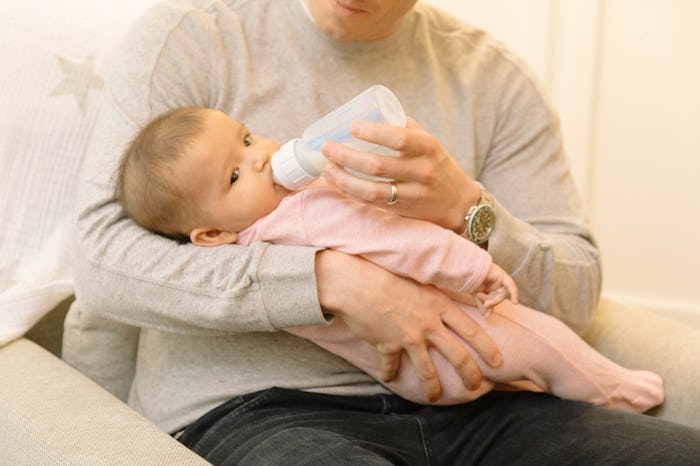Life
What Experts *Really* Want You To Know About Baby Formula & Arsenic
As a parent, you are used to doing a little investigative work when it comes to your child. You carefully read food ingredient labels and spend hours researching the best products to clothe, diaper, and carry them. That's why many parents are more than worried about a scary study released in October that found 80 percent of infant formulas tested positive for arsenic. With high numbers like that, it makes you wonder, "does all baby formula contain arsenic?" And, if so, what the heck?
"Contaminants enter our food in a variety of ways — pesticide use, industrial contamination, naturally occurring toxins, and additives," Dr. Elizabeth Meade, national spokesperson for the American Academy of Pediatrics and chief of pediatrics at Swedish Medical Center in Seattle, Washington, tells Romper. "Buying foods that are organically made, non-GMO, or additive-free/'clean' may help reduce exposure to some of these things, but there are still naturally occurring contaminants and compounds that we will never be able to completely eliminate no matter how fancy or specific the foods we buy."
According to the study funded by The Clean Label Project, a nonprofit advocating for transparent labeling, the baby food products tested had been purchased within the last five months. Of the 530 baby food products reviewed, 65 percent tested positive for arsenic, 36 percent for lead, 58 percent for cadmium, and 10 percent for acrylamide, according to USA Today. Some of the worst offenders for formula were Peaceful Planet Toddler, Abbot EleCare, and Happy Tot.
"Arsenic is an element that can be found in water or soil based foods such as rice," Dr. Danelle Fisher, a fellow of the American Academy of Pediatrics and chair of pediatrics at Providence Saint John's Health Center in Santa Monica, California, tells Romper in an email interview. "People eat small amounts of inorganic arsenic in their diet; in the United States, the estimated dietary range is 1 to 20 micrograms (mcg)/day and drinking water in the US generally contains an average of 2 mcg/L. In 2016, the FDA proposed a limit of 100 parts per billion (ppb) of inorganic arsenic in infant rice cereal (similar to European standards)."
Meade points out, however, that The Clean Label's study is "difficult to interpret for multiple reasons."
"Not only is the study not published in a peer-reviewed journal, but the Clean Label Project did not even release the complete data, so we cannot know exactly how much of any of the given compounds were present in each food," she says. "We also cannot know how they compare to standards set by the Food and Drug Administration." Like Fisher, she points out that arsenic is a naturally occurring compound. "[So] a food testing 'positive' for this doesn't mean much unless we know exactly how much was in a serving or a set amount."
Meade also says that food is just one source of exposure to metals and chemicals, and may have less of an effect on health than some other sources. For example, lead exposure from paint chips, house dust, or old pipes is a much bigger issue for most children than food-related sources of lead. She says that while some parents have asked her what signs or symptoms they might watch for because of this study, "for most toxins, it is the cumulative effect or long-term exposure that poses risk." That means you are unlikely to notice immediate symptoms. "Lead toxicity, however, can present with symptoms like anemia, intellectual or behavioral changes, or stomach pain," she says.
That being said, Meade says it's still important to know what your kids are eating and ensure that foods are safe. "Parents should focus on being educated about potential toxic exposures and talking with their child's doctor about any concerns rather than trying to interpret alarmist headlines or articles," she says.
Meade says the American Academy of Pediatrics recommends parents reduce toxic exposures from food by feeding your child a varied diet, avoiding routine use of single-serve packaging, not microwaving food in plastic containers, and choose first foods that are naturally occurring and provide key nutrients.
Of course, if you have any questions, then it's always a safe bet to talk with your child's pediatrician or family doctor about how to ensure your child is eating a balanced, healthy diet.
Plus, it will help reduce some of your super sleuthing duties which is a win-win, right?
Check out Romper's new video series, Romper's Doula Diaries:
Check out the entire Romper's Doula Diaries series and other videos on Facebook and the Bustle app across Apple TV, Roku, and Amazon Fire TV.
